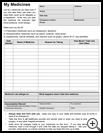
Polymyxin B/Bacitracin, Topical
pol-i-MIKS-in-B bas-i-TRAY-sin
________________________________________________________________________
KEY POINTS
- This medicine is put on the skin to treat or to prevent infections in minor cuts, wounds, burns, and skin abrasions, and to help healing. Use it exactly as directed.
- This medicine may cause unwanted side effects. Tell your healthcare provider if you have any side effects that are serious, continue, or get worse.
- Tell all healthcare providers who treat you about all the prescription medicines, nonprescription medicines, supplements, natural remedies, and vitamins that you take.
________________________________________________________________________
What are other names for this medicine?
Type of medicine: antibiotic
Generic and brand names: polymyxin B/bacitracin, topical; Polysporin Ointment (There may be other brand names for this medicine.)
What is this medicine used for?
This medicine is a combination of antibiotic medicines that you put on the skin to treat or to prevent infections in minor cuts, wounds, burns, and skin abrasions, and to help healing.
This medicine may be used to treat other conditions as determined by your healthcare provider.
What should my healthcare provider know before I take this medicine?
Check with your healthcare provider before using this medicine if you are allergic to any kind of medicine.
Females of childbearing age: Tell your healthcare provider if you are pregnant or plan to become pregnant. It is not known whether this medicine will harm an unborn baby. Do not breast-feed while taking this medicine without your healthcare provider's approval.
How do I use it?
Wash the sore area with mild soap and warm water and pat dry with a soft towel.
This medicine is available without a prescription. Check the label on the medicine for directions about your specific dose or follow your healthcare provider’s directions. Put a thin layer of medicine on your skin and rub it in gently. You may put a sterile bandage on. Use the medicine long enough to get rid of the infection or until any open wounds heal. Do not use more or less of it or use it more often than prescribed by your healthcare provider or as written on the package.
Check with your healthcare provider before using this medicine in children. Some brands should not be used in children under a certain age.
This medicine is for external use only. Do not get it in your eyes, nose, or mouth. Do not use this medicine on large areas of your body unless your healthcare provider approves.
Wash your hands before and after applying this or any other medicine to your skin.
What if I miss a dose?
If you miss a dose, use it as soon as you remember unless it is almost time for the next scheduled dose. In that case, skip the missed dose and use the next one as directed. Do not use double doses. If you are not sure of what to do if you miss a dose, or if you miss more than one dose, contact your healthcare provider.
What if I overdose?
An acute overdose of this medicine is not likely to cause life-threatening symptoms. If you think that you or anyone else may have taken too much of this medicine, call the poison control center at 800-222-1222.
What should I watch out for?
If the infection is not cleared up in a week or if it becomes worse, contact your healthcare provider. Using antibiotics on your skin for a long time may increase your risk of fungal infections. Talk with your healthcare provider about this.
Deeper cuts, puncture wounds, animal bites, or serious burns that get infected may need to be treated with antibiotics by mouth or by shots. Contact your healthcare provider for advice in treating more serious wounds or infections or those that cover large areas of your body.
If you need emergency care, surgery, lab tests, or dental work, tell the healthcare provider or dentist you are using this medicine.
What are the possible side effects?
Along with its needed effects, your medicine may cause some unwanted effects. Some side effects may go away as your body adjusts to the medicine. Tell your healthcare provider if you have any side effects that continue or get worse.
Life-threatening (Report these to your healthcare provider right away. If you cannot reach your healthcare provider right away, get emergency medical care or call 911 for help.): Allergic reaction (hives; itching; rash; trouble breathing; tightness in your chest; swelling of your lips, tongue, and throat).
Serious (Report these to your healthcare provider right away.): New or worsening skin irritation, redness, swelling, or pus while you are using this medicine; unexplained fever.
Other: Mild stinging or burning when the medicine is applied.
What products might interact with this medicine?
No significant drug interactions have been reported. However, the use of other products on your skin at the same time may not be helpful. Read the label on the package to find out if you should take any special precautions.
If you are not sure if your medicines might interact, ask your pharmacist or healthcare provider. Keep a list of all your medicines with you. List all the prescription medicines, nonprescription medicines, supplements, natural remedies, and vitamins that you take. Be sure that you tell all healthcare providers who treat you about all the products you are taking.
How should I store this medicine?
Store this medicine at room temperature. Keep the container tightly closed. Protect it from heat, high humidity, and bright light.
This advisory includes selected information only and may not include all side effects of this medicine or interactions with other medicines. Ask your healthcare provider or pharmacist for more information or if you have any questions.
Ask your pharmacist for the best way to dispose of outdated medicine or medicine you have not used. Do not throw medicine in the trash.
Keep all medicines out of the reach of children.
Do not share medicines with other people.
Last modified: 2016-07-21
Last reviewed: 2016-07-21

